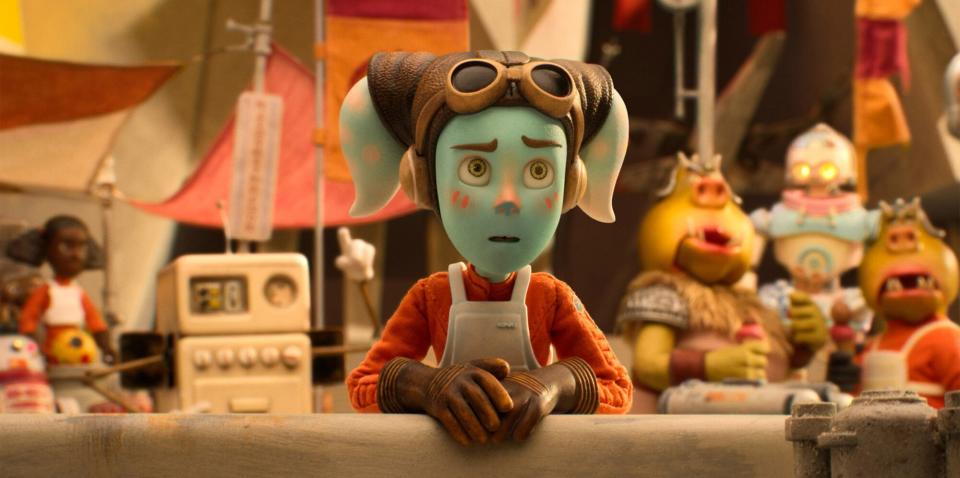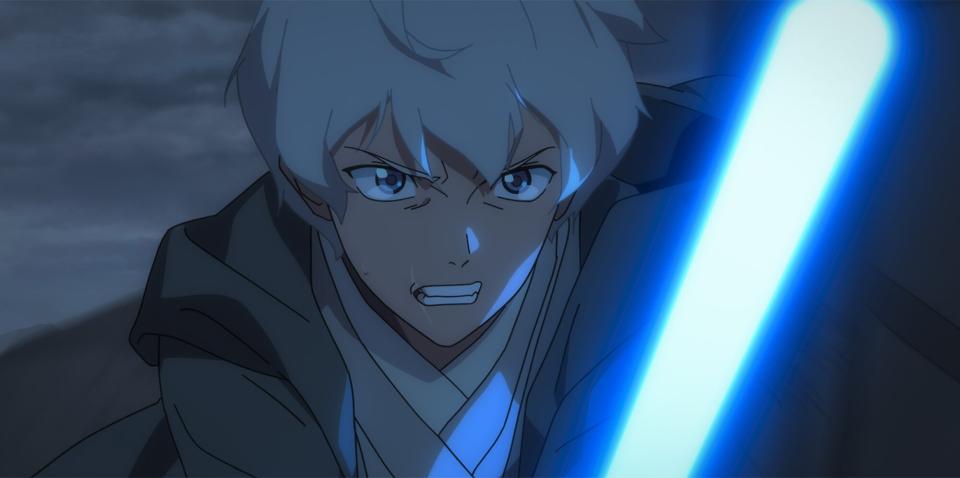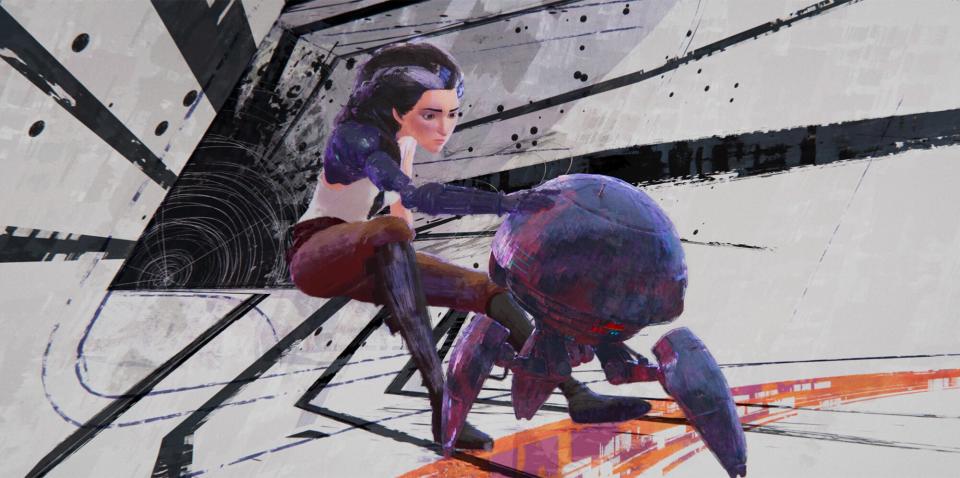How Star Wars: Visions went global for its spectacular season 2
The first season of Star Wars: Visions was a welcome surprise. This inventive anthology series found Lucasfilm teaming up with seven Japanese anime studios, each crafting an original short set in a galaxy far, far away. Now Visions is returning for its much-anticipated second season, this time collaborating with animators from around the globe.
For season 2 (out now on Disney+), the Visions team recruited nine animation studios from nine different countries, asking each to create its own unique Star Wars short. The studios hail from Spain (El Guiri), Ireland (Cartoon Saloon), Chile (Punkrobot), the United Kingdom (Aardman), South Korea (Studio Mir), France (Studio La Cachette), India (88 Pictures), Japan (D'ART Shtajio), and South Africa (Triggerfish). The result is an eclectic mix of Star Wars storytelling, each with its own distinct art style.
Each episode is deeply rooted in the Star Wars universe, featuring aspiring Jedi warriors, Rebel spies, and high-flying pilots. (A familiar character from the original trilogy even makes a cameo.) But each studio brings a unique cultural specificity to its episode — whether it's a ghost story inspired by Irish folktales or a colorful train heist that draws from Indian culture. The result is some of the freshest and most original storytelling Star Wars has done in decades. (It's also got a starry voice cast that includes Daveed Diggs, Anjelica Huston, and Cynthia Erivo.)
Ahead of the season's release, executive producers James Waugh, Josh Rimes, and Jacqui Lopez sat down with EW's Dagobah Dispatch podcast and opened up about bringing a global perspective to the Star Wars galaxy.

Disney+ Anni in a scene from the 'Star Wars: Visions' season 2 episode 'I Am Your Mother,' created by legendary U.K. studio Aardman
ENTERTAINMENT WEEKLY: For season 1, you collaborated with a bunch of incredible Japanese anime studios. For season 2, you expanded your reach to work with studios all around the world. Why was it important to go global for season 2?
JAMES WAUGH: There's a couple reasons. First off, it's worth saying that we are massive animation fans, period. We devour tons of animated content. We love these studios, and we're fortunate that so many of them love the work that we do. I really do believe that some of the best filmmaking period is being done in animation at the moment.
There is such a global community of animation now that is doing incredible work — not just pushing different forms of animation or different styles, but different kinds of storytelling. We thought: How amazing would it be to see Star Wars through the lens of these different cultures? How do we take what we learned on volume 1 and see a Chilean perspective, with all the history that comes with that? How do we see the myths of Ireland interpreted that way, or the very dry British humor of Aardman? We wanted to open the door to those types of experiences and see how Star Wars would look through that. That was really exciting to us.
When we pitched it, everybody was really excited by that evolution. It was like, "Well, anime works, and anime is great, and we definitely want to see more Star Wars anime." But there's such great storytelling happening in this medium around the world, and we wanted to showcase that.
What's the pitching process like with these studios? Did they come to you with an idea, or did you approach them?
JACQUI LOPEZ: We approached them. We knew we could have nine [episodes], so we had to figure out who we could approach and make sure it represented as much of a global perspective as possible. We asked them, would they be interested? Do they have a Star Wars story to tell? They then came back to us with their stories.
Some studios had one story that they felt like they had to tell. Other studios had different filmmakers pitch, so they had anywhere from two to six pitches for us. We curated it from there. It was also important for us to get different styles of animation, to make sure we had some 2-D, some 3-D, some stop-motion.

Disney+ Toul in a scene from the 'Star Wars: Visions' season 2 episode 'Journey to the Dark Head,' by South Korea's Studio Mir
One of the things I really love about this season is how you play with all those different animation formats: stop-motion, 2-D, 3-D. For you as storytellers, what was fun about getting to play with all these different styles?
JOSH RIMES: A lot. We were hoping that we'd get to see different formats going in. With Punkrobot for example, we loved Bear Story, their Oscar-winning short. That was a CGI-animated piece that also had an amazing wind-up toy feel to it. It almost felt like stop-motion. So they brought a sort of tactile stop-motion feel to their short, "In the Stars," about these two sisters, and it somehow made it more emotional. You look at Triggerfish also, which doesn't feel like traditional stop-motion. It's a CGI piece, but it's very tactile and has those colorful felt-like creatures. The storytelling and the characters' journeys sort of dovetail with the style, and that elevates it even more.
We were getting all these textures from around the world. Of course, there's the hand-drawn animation from Studio Mir [in South Korea] and La Cachette in France. We were super lucky to be in the hands of great artists who were putting their storytelling prowess and their craftsmanship to great work.
WAUGH: Jacqui talked about how some creators brought in six different pitches, and the thing we were looking for creatively was a human story. We wanted a story that you could strip away the Star Wars and it would still be relatable and could shine the light on the human experience. I think that's where Star Wars really functions at its best, when it's telling mythic, resonant stories. The style and the bombast can come afterwards. When we knew a filmmaker had a voice and had something to say, then we knew we were in the right place.
A lot of stories this season are about family: You've got mothers and daughters, brothers and sisters, even some found-family stories. Was that a theme you were talking about as you were assembling the season?
WAUGH: There's nothing that we led with, saying, "These are the types of themes that we want to hear from you." We wanted to see what Star Wars meant to all of them. And even though so many of them wanted to interpret Star Wars in new ways, those core elements hold true. There's something about that found-family idea, choosing your higher calling, choosing selflessness over being selfish — all these things are so inherent in Star Wars, and they got it. The stories that kind of resonated were those Star Wars themes. But we never directed them towards it. We helped them refine.
LOPEZ: You know what I loved too? The different ways the Force was represented. Some of it was very personal to the filmmaker. Like for Rodrigo Blaas from Spain, it was art expression — the ability to express yourself and create art and create your own path, which is very personal to him.
As well as on the Triggerfish [short] with Nadia [Darries], who is a singer. Her ability to sing is her self-expression that frees her. So that's another beautiful thing, taking these really personal stories from different countries. Your life experience comes from your environment.

Disney+ Lola and E2 in a scene from the 'Star Wars: Visions' season 2 episode 'Sith,' by Spain's El Guiri
You talked about finding different ways to bring cultural specificity into the Star Wars galaxy. Were there any specific examples of that you really loved?
WAUGH: "Bandits of Golak."
RIMES: That's a good one.
WAUGH: That film is so alive. You feel the Indian culture and the heritage exuding through, from all the different bright lights to the final battle with the Sith. The Sith feels like it stepped out of one of the mythic plays or a Bollywood film, in a way. They wanted that from the start. The original pitch was about dhabas, these cool truck stops that are full of lights and color.
RIMES: And don't forget the food! That's a huge part of it.
LOPEZ: I just remember reading their script and seeing their designs and thinking, "This is too ambitious. They're not going to be able to finish this on this budget or schedule." [Laughs] But they were like, "We have to have this music, and we have to have all these colors, and we have to have the food. If it's not crowded, it won't feel like India!" They were just so excited to have an expression of their culture in the Star Wars galaxy. It was an incredibly joyful experience.
RIMES: Cartoon Saloon is another one. Their movies are so steeped in Celtic and Irish myth and history. So they wanted to do a banshee story. They were inspired by their own Celtic myths but also the idea of a Jedi. They were like, "That idea of Luke Skywalker entering a cave and facing his fears really resonated with us immediately."
WAUGH: They all have a bit of that. La Cachette was really inspired by the French Revolution and the cabaret dancers and Mata Hari — singers who also lived a double life to help the greater good. You only get that from a studio based in Paris.
This interview has been edited for length and clarity.
To hear our entire interview with the Star Wars: Visions team, check out the latest episode of EW's Dagobah Dispatch podcast.
Related content:

